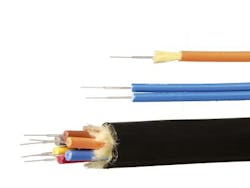Laser Components (Germany) recently announced that it now offers its own full line of fiber-optic cabling. Available immediately, the product portfolio includes both indoor and outdoor cables, ranging from simplex cables to duplex cables to multi-channcel breakout cables that are compatible with all standard connector systems.
Custom solutions are also available, says the company. Step-index fibers with a particularly high coupling efficiency are used in all cables, allowing the application of inexpensive emitter and receiver components. The cabling's numerical aperture is 0.37; the diameters of standard cables include 2.2 mm, 2.5 mm, and 3.0 mm.
See: Anixter defines best practices for LSZH wire and cable
Available cable materials include PVC, PE and PU; OFNR-/OFNP-classified materials with low-smoke characteristics for LSZH, riser, and plenum applications are also available. Most cables can be delivered both with and without aramid yarn for strain relief purposes. The company recommends that its strain relief cabling should be used with SMA and ST connectors.
More information is available here.
About the Author
Matt Vincent
Senior Editor
Matt Vincent is a B2B technology journalist, editor and content producer with over 15 years of experience, specializing in the full range of media content production and management, as well as SEO and social media engagement best practices, for both Cabling Installation & Maintenance magazine and its website CablingInstall.com. He currently provides trade show, company, executive and field technology trend coverage for the ICT structured cabling, telecommunications networking, data center, IP physical security, and professional AV vertical market segments. Email: [email protected]

